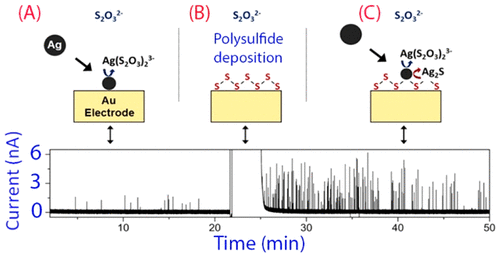当前位置:
X-MOL 学术
›
J. Am. Chem. Soc.
›
论文详情
Our official English website, www.x-mol.net, welcomes your
feedback! (Note: you will need to create a separate account there.)
Collision, Adhesion, and Oxidation of Single Ag Nanoparticles on a Polysulfide-Modified Microelectrode
Journal of the American Chemical Society ( IF 14.4 ) Pub Date : 2021-09-22 , DOI: 10.1021/jacs.1c07164 Peter A Defnet 1 , Bo Zhang 1
Journal of the American Chemical Society ( IF 14.4 ) Pub Date : 2021-09-22 , DOI: 10.1021/jacs.1c07164 Peter A Defnet 1 , Bo Zhang 1
Affiliation

|
We report the collision, adhesion, and oxidation behavior of single silver nanoparticles (Ag NPs) on a polysulfide-modified gold microelectrode. Despite its remarkable success in volume analysis for smaller Ag NPs, the method of NP-collision electrochemistry has failed to analyze particles greater than 50 nm due to uncontrollable collision behavior and incomplete NP oxidation. Herein, we describe the unique capability of an ultrathin polysulfide layer in controlling the collision behavior of Ag NPs by drastically improving their sticking probability on the electrode. The ultrathin sulfurous layer is formed on gold by sodium thiosulfate electro-oxidation and serves both as an adhesive interface for colliding NPs and as a preconcentrated reactive medium to chemically oxidize Ag to form Ag2S. Rapid particle dissolution is further promoted by the presence of bulk sodium thiosulfate serving as a Lewis base, which drastically improves the solubility of generated Ag2S by a factor of 1013. The combined use of polysulfide and sodium thiosulfate allows us to observe a 25× increase in NP detection frequency, a 3× increase in peak amplitude, and more complete oxidation for larger Ag NPs. By recognizing how volumetric analysis using transmission electron microscopy (TEM) may overestimate quasi-spherical NPs, we believe we can have full NP oxidation for particles up to 100 nm. By focusing on the electrode/solution interface for more effective NP-electrode contact, we expect that the knowledge learned from this study will greatly benefit future NP collision systems for mechanistic studies in single-entity electrochemistry as well as designing ultrasensitive biochemical sensors.
中文翻译:

单银纳米粒子在多硫化物修饰微电极上的碰撞、粘附和氧化
我们报告了单个银纳米粒子 (Ag NPs) 在多硫化物修饰的金微电极上的碰撞、粘附和氧化行为。尽管在较小的 Ag NPs 体积分析方面取得了显著成功,但由于无法控制的碰撞行为和不完全的 NP 氧化,NP 碰撞电化学方法未能分析大于 50 nm 的颗粒。在这里,我们描述了超薄多硫化物层通过显着提高其在电极上的粘附概率来控制 Ag NPs 碰撞行为的独特能力。超薄硫磺层通过硫代硫酸钠电氧化在金上形成,既用作碰撞 NP 的粘合界面,也用作化学氧化 Ag 形成 Ag 2的预浓缩反应介质S. 大量硫代硫酸钠作为路易斯碱的存在进一步促进了颗粒的快速溶解,这将生成的 Ag 2 S 的溶解度大幅提高了 10 13倍. 多硫化物和硫代硫酸钠的联合使用使我们能够观察到 NP 检测频率增加了 25 倍,峰值幅度增加了 3 倍,并且对于较大的 Ag NP,氧化更完全。通过认识到使用透射电子显微镜 (TEM) 进行体积分析可能会高估准球形 NP,我们相信我们可以对高达 100 nm 的颗粒进行完全的 NP 氧化。通过关注电极/溶液界面以实现更有效的 NP 电极接触,我们期望从这项研究中学到的知识将极大地有益于未来的 NP 碰撞系统,用于单实体电化学的机理研究以及设计超灵敏的生化传感器。
更新日期:2021-10-06
中文翻译:

单银纳米粒子在多硫化物修饰微电极上的碰撞、粘附和氧化
我们报告了单个银纳米粒子 (Ag NPs) 在多硫化物修饰的金微电极上的碰撞、粘附和氧化行为。尽管在较小的 Ag NPs 体积分析方面取得了显著成功,但由于无法控制的碰撞行为和不完全的 NP 氧化,NP 碰撞电化学方法未能分析大于 50 nm 的颗粒。在这里,我们描述了超薄多硫化物层通过显着提高其在电极上的粘附概率来控制 Ag NPs 碰撞行为的独特能力。超薄硫磺层通过硫代硫酸钠电氧化在金上形成,既用作碰撞 NP 的粘合界面,也用作化学氧化 Ag 形成 Ag 2的预浓缩反应介质S. 大量硫代硫酸钠作为路易斯碱的存在进一步促进了颗粒的快速溶解,这将生成的 Ag 2 S 的溶解度大幅提高了 10 13倍. 多硫化物和硫代硫酸钠的联合使用使我们能够观察到 NP 检测频率增加了 25 倍,峰值幅度增加了 3 倍,并且对于较大的 Ag NP,氧化更完全。通过认识到使用透射电子显微镜 (TEM) 进行体积分析可能会高估准球形 NP,我们相信我们可以对高达 100 nm 的颗粒进行完全的 NP 氧化。通过关注电极/溶液界面以实现更有效的 NP 电极接触,我们期望从这项研究中学到的知识将极大地有益于未来的 NP 碰撞系统,用于单实体电化学的机理研究以及设计超灵敏的生化传感器。










































 京公网安备 11010802027423号
京公网安备 11010802027423号